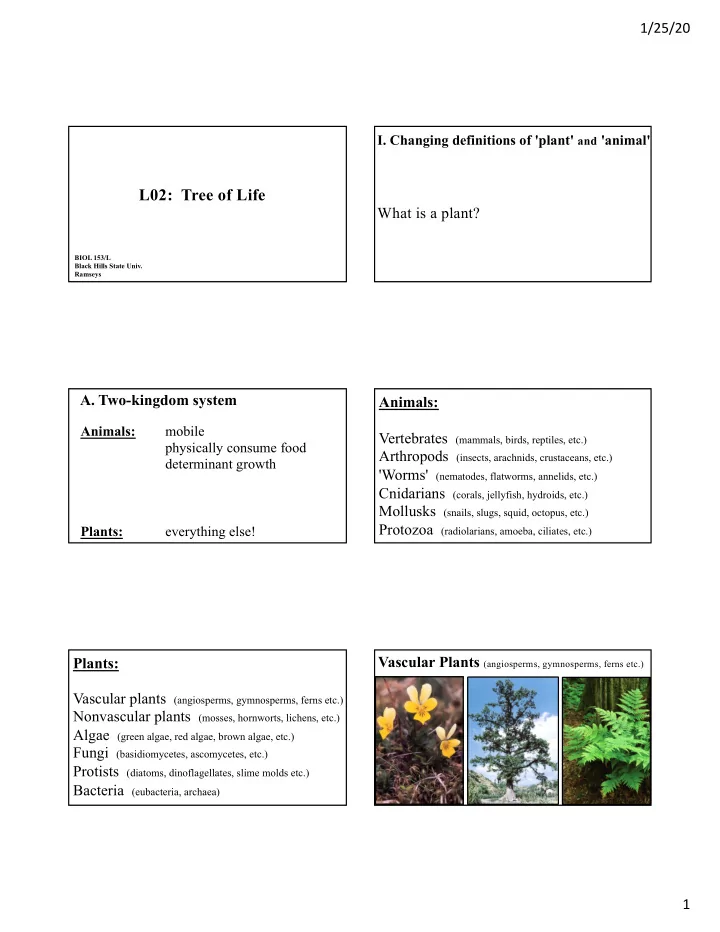

1/25/20 I. Changing definitions of 'plant' and 'animal' L02: Tree of Life What is a plant? BIOL 153/L Black Hills State Univ. Ramseys A. Two-kingdom system Animals: Animals: mobile Vertebrates (mammals, birds, reptiles, etc.) physically consume food Arthropods (insects, arachnids, crustaceans, etc.) determinant growth 'Worms' (nematodes, flatworms, annelids, etc.) Cnidarians (corals, jellyfish, hydroids, etc.) Mollusks (snails, slugs, squid, octopus, etc.) Protozoa (radiolarians, amoeba, ciliates, etc.) Plants: everything else! Vascular Plants (angiosperms, gymnosperms, ferns etc.) Plants: Vascular plants (angiosperms, gymnosperms, ferns etc.) Nonvascular plants (mosses, hornworts, lichens, etc.) Algae (green algae, red algae, brown algae, etc.) Fungi (basidiomycetes, ascomycetes, etc.) Protists (diatoms, dinoflagellates, slime molds etc.) Bacteria (eubacteria, archaea) 1
1/25/20 Nonvascular Plants (mosses, hornworts, lichens, etc.) Algae (green algae, red algae, brown algae, etc.) Fungi (basidiomycetes, ascomycetes, etc.) Protists (diatoms, dinoflagellates, slime molds etc.) B. Three-kingdom system Bacteria (eubacteria, archaea) Animals: mobile physically consume food determinant growth Plants: everything else, except... Bacteria: prokaryotes 2
1/25/20 Prokaryotes C. Five-kingdom system Eukaryotes: animals, plants, fungi, protists Prokaryotes: bacteria very small, single-celled, haploid, lack nuclei and organelles How Organisms Eat Uni- Multi- Auto- Hetero- cellular cellular Immobile Mobile trophic trophic Autotrophy: self-feeding (makes own food) X X X Animals x x x X X X Plants x x x X X X Fungi X x Heterotrophy: other-feeding (eats other organisms) X X X X X Protists X II. Morphology and its limits A. Morphology definition shape, size, arrangement of parts used to group organisms in 2-K, 3-K, 5-K systems 3
1/25/20 Example A: Dog Family (Canidae) B. Well-defined groups of organisms Frances (pomeranian) Hiesey (border collie) Example A: Dog Family (Canidae) Example A: Dog Family (Canidae) Example B: Sunflower Family (Asteraceae) Example B: Sunflower Family (Asteraceae) 4
1/25/20 B. Well-defined groups of organisms C. Poorly-defined groups of organisms 1. Medium to large size 2. Many traits to measure 3. Common and widespread 4. Easily observed Example A: Bacteria Example B: Threadplants ( Nemacladus ) Example B: Threadplants ( Nemacladus ) Example B: Threadplants ( Nemacladus ) 5
1/25/20 D. Interpretation difficulties C. Poorly-defined groups of organisms 1. Small or microscopic 2. Few traits to measure 3. Rare 4. Difficult to observe Example: Euphorbs, Cacti & Milkweeds Convergent evolution of traits: similar traits evolve in unrelated organisms as environmental adaptations Raven p. 239 water-storing stems, leaves modified as sharp appendages Example: Reptiles Convergent evolution of traits: similar traits evolve in unrelated organisms as environmental adaptations Evolutionary loss of traits: traits lost within groups of organisms (environmental adaptation or lack-of-use) loss-of-limbs in snakes, Amphisbaena, and lizards 6
1/25/20 III. Molecular data DNA info directly or indirectly derived from DNA (more info in BIOL 153 Part 2!) B. Advantages C. Disadvantages • High info content • Trouble and expense • All living organisms have DNA • Not all organisms living! • Few issues with convergence • Few issues with evolutionary loss IV. Phylogeny A. Phylogeny definition hypothesis regarding organism relationships based on morphology or molecular data, and expressed in graphical form 7
1/25/20 • Organisms B. 'Trees' ( a , b , c , d , e , f ) a a b b c c • Groupings d d ( a , b , c ) vs. ( d , e , f ) e e ( a ) vs. ( b , c ) ( d , e ) vs. ( f ) f f • Nodes ( ) C. 'Tree' shape and form common ancestor a b c one tree can be drawn in different ways! • Branches d length => time e f C. 'Tree' shape and form C. 'Tree' shape and form 8
1/25/20 V. Domains A. Domain definition major organism groups defined by molecular phylogenetics B. Three domains currently recognized Eubacteria, Archaea, and Eukarya Eukarya 9
1/25/20 C. Prokaryotes • Two highly divergent groups • Incredible genetic + metabolic diversity VI. New view of Eukaryotes D. Eukaryotes • One group • Related more to Archaea • Incredible structural diversity + complexity Two-Kingdom system A. Problems with 2-K, 3-K, 5-K systems on Tree of Life 1. Group unrelated organisms 2. Kingdoms with different sizes 10
1/25/20 Five-Kingdom system B. 'Protists' on Tree of Life (mostly) unicellular eukaryotes w/ diverse lifestyles protists not all closely related to each other Five-Kingdom system C. Plants and 'Algae' on Tree of Life land plants are natural grouping, related to green and red algae. other 'algae' are distantly related to true plants land plants D. Fungi green algae red algae brown algae golden algae most fungi are natural grouping diatoms (and very closely related to animals) some 'molds' are distantly related to true fungi 11
1/25/20 E. Supergroups newly-named clusters identified by phylogenetics slime mold not intuitive or familiar to most people! fungi Fig. 12-10 Raven p. 245 12
Recommend
More recommend